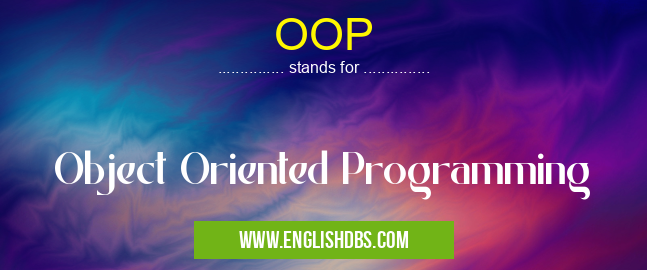What does OOP mean in SOFTWARE
OOP (Object Oriented Programming) is a programming paradigm that uses "objects" to design applications and computer programs. "Objects" are data structures consisting of data fields and methods together with their interactions. This makes it easier to create complex programs that are easier to maintain and reuse. OOP is based on several concepts such as Encapsulation, Abstraction, Inheritance, and Polymorphism. Ultimately, OOP aims to imitate and simplify the real world by programming objects that contain both data and functions.

OOP meaning in Software in Computing
OOP mostly used in an acronym Software in Category Computing that means Object Oriented Programming
Shorthand: OOP,
Full Form: Object Oriented Programming
For more information of "Object Oriented Programming", see the section below.
Key Features of OOP
- Encapsulation: Bundling data and methods that operate on that data within a single unit, called an object.
- Abstraction: Hiding the internal details and implementation of an object from the user, only exposing its essential features.
- Inheritance: Creating new classes (derived classes) from existing classes (base classes), inheriting their properties and behaviors.
- Polymorphism: Allowing objects of different classes to respond to the same message in different ways, based on their own implementation.
Benefits of OOP
- Modularity: Breaking down complex problems into smaller, manageable modules (objects).
- Reusability: Reusing existing objects and classes in different programs, saving time and effort.
- Maintainability: Making it easier to modify and update code as requirements change.
- Extensibility: Allowing for the addition of new features and functionality without affecting existing code.
Common OOP Languages
- C++
- Java
- Python
- C#
- JavaScript
Essential Questions and Answers on Object Oriented Programming in "COMPUTING»SOFTWARE"
What is the main concept of OOP?
OOP follows the concept of bundling data and methods that operate on that data into a single unit called an object. It emphasizes data encapsulation, inheritance, and polymorphism to enhance code reusability, maintainability, and extensibility.
How does OOP differ from procedural programming?
In procedural programming, data and functions exist independently, while in OOP, they are combined into objects. OOP focuses on creating modular and reusable code, simplifying development and maintenance.
What are the benefits of using OOP?
OOP offers several benefits, including:
- Code reusability through inheritance
- Improved maintainability due to encapsulation
- Increased extensibility by allowing for easy addition of new features
- Enhanced security by protecting data from unauthorized access
What are the key principles of OOP?
The fundamental principles of OOP include:
- Encapsulation: Bundling data and methods into a single unit
- Inheritance: Creating new classes from existing classes
- Polymorphism: Allowing objects of different types to respond to the same message in a uniform manner
What is an object in OOP?
An object is a self-contained entity that combines data and methods. It represents a real-world concept and has a unique state and behavior. Objects interact with each other through method calls.
What is a class in OOP?
A class is a blueprint or template that defines the structure and behavior of objects. It specifies the data members and methods that objects of that class will have. Classes help in code organization and reusability.
How can inheritance be used in OOP?
Inheritance allows new classes (derived classes) to inherit properties and methods from existing classes (base classes). It promotes code reusability, reduces redundancy, and supports the "is-a" relationship between objects.
Final Words: OOP is a powerful programming paradigm that has revolutionized software development. By organizing code into objects, OOP enhances code readability, maintainability, and reusability. Its key concepts of encapsulation, abstraction, inheritance, and polymorphism enable the creation of complex and efficient software applications. Understanding OOP is crucial for anyone aspiring to become a proficient software developer.
